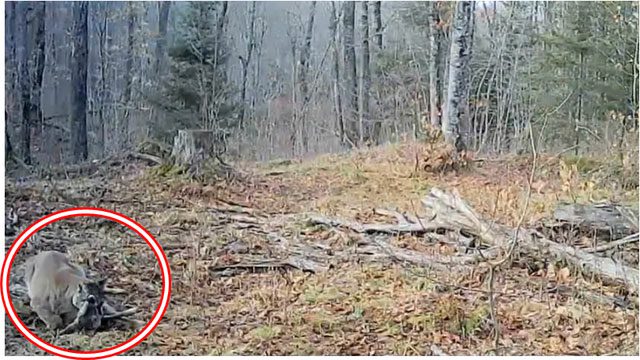The Young Hunter Shocked to Find Extinct Creature Captured by Camera Trap
Eli Schaefer, a 24-year-old hunter, has been actively hunting in the forests of the Keweenaw Peninsula in Michigan’s Upper Peninsula for many years. He has often encountered large wildlife while hunting deer. However, in December 2023, an unexpected event left Eli and local scientists utterly astonished.

Eli’s camera trap accidentally captured a mountain lion hunting a white-tailed deer. (Photo: Mlive).
While setting up his camera trap to record animals in the forest, Eli stumbled upon a mountain lion chasing a white-tailed deer. The video shows the lion pouncing on the deer and gripping tightly to its spine. It took only a few seconds for the big cat to immobilize its prey completely. Later, in a second video that Eli posted on Facebook on January 7, the mountain lion was seen dragging its prey away before disappearing from the frame. Notably, mountain lions have been confirmed by scientists in Michigan to be extinct in this area since the 1900s, over 100 years ago.
Eli mentioned that in 2021, he had come across large blood-stained paw prints in the snow, roughly the size of an adult human hand. Following the tracks for about two miles, he initially believed they were made by a lynx. However, now, after the discovery of the mountain lion, Eli is convinced that the tracks from 2021 were left by it.
Mountain lions have been confirmed by scientists in Michigan to have been locally extinct since the early 1900s, over 100 years ago.
Brian Roell, a wildlife biologist with the Michigan Department of Natural Resources (MDNR), shared with MLive.com: “This is the first time I’ve seen this confirmed extinct species again. The chance of this discovery is truly rare. I hope this finding will greatly aid in the conservation and development of mountain lions in the future.”
Michigan wildlife officials believe that sightings of mountain lions like Eli’s are due to solitary male cats dispersing from long-established populations in the West.
The mountain lion (scientific name: Puma concolor) is a large cat species, second only to the jaguar in size. They have long, strong bodies covered in tan fur, with a grayish-white belly and chest. Their weight can reach up to 64-141 kg for females and 115-220 kg for males.
Mountain lions once roamed throughout the Americas, from Yukon in Canada to the Strait of Magellan, and they have the widest distribution of any land mammal in the Americas. They can adapt to many different habitats, from mountains to dense forests, and from deserts to wetlands.
Mountain lions were once hunted due to the threats they posed to livestock. As a result, they were nearly completely eradicated in the eastern United States. However, thanks to conservation efforts, the mountain lion population in the western United States has stabilized, although still significantly lower than historical levels.
The discovery of mountain lion individuals is not only exciting news for the scientific community but also serves as a powerful message about the importance of biodiversity conservation in Michigan and across the United States.


















































